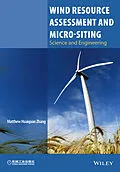Covers all the key areas of wind resource assessment technologies from an engineer's perspective
* Focuses on wind analysis for wind plant siting, design and analysis
* Addresses all aspects from atmospheric boundary layer characteristics, to wind resource measurement systems, uncertainties in measurements, computations and analyses, to plant performance
* Covers the basics of atmospheric science through to turbine siting, turbine responses, and to environmental impacts
* Contents can be used for research purposes as well as a go-to reference guide, written from the perspective of a hands-on engineer
* Topic is of ongoing major international interest for its economic and environmental benefits
Autorentext
Matthew Huaiquan Zhang,
Independent Renewable Energy Consultant, China/ UK
Inhalt
Preface xiii
Introduction xv
Acknowledgments xvii
About the Author xix
List of Symbols xxi
1 Introduction 1
1.1 Wind Resource Assessment as a Discipline 2
1.2 Micro-siting Briefing 2
1.3 Cascade of Wind Regime 3
1.3.1 Global Scale Wind Regime 3
1.3.2 Synoptic Scale Wind Regime 5
1.3.3 Meso-scale Wind Regime 5
1.3.4 Local Scale Wind Regime 6
1.4 Uncertainty of Wind Resource 7
1.5 Scope of the Book 9
References 9
2 Concepts and Analytical Tools 11
2.1 Surface Roughness and Wind Profile 11
2.1.1 Roughness Length 11
2.1.2 Vertical Wind Profile 14
2.1.3 Internal Boundary Layer 15
2.1.4 Roughness Change Model 16
2.1.5 Displacement Height 17
2.1.6 Wind Shear 18
2.2 Speed-up Effect of Terrain 20
2.2.1 Horizontal Speed-up Profile 20
2.2.2 Vertical Speed-up on Hill Top 22
2.2.3 Orographic Categorisation of Terrain 24
2.2.4 Ruggedness Index 27
2.3 Shelter Effect of Obstacles 28
2.3.1 Reduced Wind Speed 29
2.3.2 Increased Turbulence Intensity 31
2.4 Summary 32
References 33
3 Numerical Wind Flow Modelling 35
3.1 Modelling Concept Review 36
3.1.1 Wind Flow Concepts 36
3.1.2 Governing Equations 37
3.1.3 Meshing the Computational Domain 41
3.2 Linearised Numerical Flow Models 42
3.2.1 JacksonHunt Model 42
3.2.2 WAsP Model: The Principle 43
3.2.3 WAsP Model: Limitations 46
3.2.4 WAsP Model: Improving the Results 48
3.3 Mass-Consistent Models 50
3.4 CFD Models 50
3.4.1 Meteodyn WT and WindSim 51
3.4.2 Validation of CFD models 52
3.5 Meso Scale NWP Models 53
3.6 Inherent Uncertainties in Wind Flow Modelling 55
3.7 Summary 56
References 56
4 Wind Park Physics and Micro-siting 61
4.1 Wind Power Density 61
4.2 Wind Power Conversion 63
4.2.1 Betz's Limit 63
4.2.2 Power Coefficient 65
4.2.3 Thrust Coefficient 65
4.2.4 Wind Turbine Power Curve 66
4.2.5 Power Curve Adjustment 67
4.3 Wind Turbine Wake Effects 68
4.3.1 Analytical Structure of Wake 68
4.3.2 Reduced Velocity Wake Models 70
4.3.3 Added Turbulence Wake Models 73
4.3.4 Deep Array Wake Models 75
4.3.5 Wake Effects in Complex Terrain 77
4.4 Wind Turbine Micro-siting 78
4.4.1 Park Efficiency 79
4.4.2 Capacity Factor 80
4.4.3 Site-Specific Wind Conditions 80
4.4.4 Wind Turbine Selection 82
4.4.5 Site Survey 83
4.4.6 Wind Sector Management 86
4.5 Summary 87
References 87
5 Wind Statistics 91
5.1 Statistics Concepts Review 91
5.1.1 Random Variables 91
5.1.2 Sample Mean and Standard Deviation 92
5.1.3 Probability Density Distribution 92
5.2 Wind Data Time Series 93
5.2.1 Mean Wind Speed 94
5.2.2 Turbulence Intensity 95
5.2.3 Wind Direction 97
5.3 Mean Wind Speed of the Whole Time Series 99
5.4 Weibull Distribution 100
5.4.1 Weibull Probability Density Function 100
5.4.2 Weibull Cumulative Distribution Function 101
5.4.3 Rayleigh Distribution 103
5.5 Estimating Weibull Parameters 104
5.5.1 Linear Regression Method 104
5.5.2 Mean-Standard Deviation Method 105
5.5.3 Maximum Likelihood Estimate Method 105
5.5.4 Medians Method 106
5.5.5 Power Density Method 107
5.5.6 Quality of the Weibull Fit 108
5.6 Extreme Wind Statistics 110
5.6.1 Independent Extreme Wind Events 110
...
